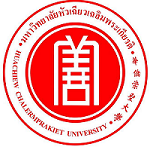Please use this identifier to cite or link to this item:
https://has.hcu.ac.th/jspui/handle/123456789/1072| Title: | ปริศนากวีผะหมี : กรณีศึกษาอำเภอบางบ่อ จังหวัดสมุทรปราการ |
| Other Titles: | A Study of a Pami Riddle in Bang Bo District, Samut Prakan Province |
| Authors: | นราวดี พันธุ์นรา Narawadee Pannara Huachiew Chalermprakiet University. Faculty of Liberal Arts |
| Keywords: | ผะหมี. Pami Riddle ปริศนา Puzzles ภาษาไทย -- การใช้ภาษา Thai language -- Usage |
| Issue Date: | 1999 |
| Publisher: | มหาวิทยาลัยหัวเฉียวเฉลิมพระเกียรติ |
| Abstract: | การวิจัยครั้งนี้มีวัตถุประสงค์เพื่อรวบรวมข้อมูลของผะหมี เพื่อศึกษาลักษณะและเนื้อหาของผะหมี และเพื่อศึกษาประโยชน์และคุณค่าจากผะหมี โดยรวบรวมข้อมูลจากการสัมภาษณ์และสังเกตการณ์ที่อำเภอบางบ่อ จังหวัดสมุทรปราการ ผลการวิจัยสรุปว่าผะหมี คือ ปริศนาคำทายที่ได้รับจากจีน แต่ได้ดัดแปลงให้เข้ากับภาษาไทย การเล่นผะหมีประกอบด้วยผู้เล่น 2 ฝ่าย ซึ่งมีทั้งผู้ตั้งปริศนาและผู้ตอบปริศนา ผะหมีไม่เพียงแต่เล่นในเทศกาลต่าง ๆ เท่านั้น แต่ยังเล่นในยามว่างได้ด้วย ผะหมีที่อำเภอบางบ่อ จังหวัดสมุทรปราการ มีทั้งปริศนาภาพและปริศนาอักษร ซึ่งนิยมแต่งเป็นร้อยกรอง เช่นโคลง กาพย์ยานี 11 กาพย์ฉบัง 16 สักวา กลอนดอกสร้อย หรือกระจุ๋มกระจิ๋ม จุลพจน์ จตุพจน์ ทศ ซึ่งเป็นลักษณะปริศนาที่คิดขึ้นเพื่อใช้กับการเล่นผะหมี สำหรับลักษณะคำตอบมี 4 ลักษณะ คือ คำตอบพ้องเสียงทั้งพ้องเสียงพยางค์ พยัญชนะ และสระ คำตอบผันวรรณยุกต์ คำตอบผวนคำ และคำตอบต่อคำ สำหรับเนื้อหาผะหมีได้ให้ความรู้มากมาย ซึ่งสะท้อนให้เห็นความเป็นผู้รอบรู้ และเป็นนักคิดของผู้เล่นผะหมี ผะหมีนอกจากจะให้ความสนุกสนานแล้วยังแฝงความรู้มากมาย และยังสะท้อนให้เห็นเรื่องราว สถานที่ บุคคล ทัศนคติ ความเชื่อ ค่านิยมในสังคม ภาษา ตลอดจนการเรียนรู้ต่าง ๆ The aim of this research is to collect Pami question and answer to study its characteristics and content, including its utilities. Data is collected by interview and observation at Bang Bo District, Samut Prakan Province. This research found that a word game, Pami, is a kind of Chinese riddle. It has been adapted to the Thai language. Pami consists of two sides of players, making puzzling questions and answering puzzling questions. Pami is not only played in festival but also in leisure time. Pami riddles have two types of puzzles: pictures and verses such as Klong, Kap- Yani 11, Kap-Chabang 16, Sak-Kawa, Klon Dok-Soi, Krachum-Krachim, Chunlapot, Chatupot and Tot. Four types of answers to the puzzles are in forms of words that sound is the same on syllables, consonants and vowels, changes in tone, puns, and extended words. Pami content comprises of much of knowledges. It reflects the players’ knowledge and thoughfulness. Pami is fun and educational. Also, it reflects events, names and meaning of places, persons, attitude, belief, social values, Language and learning. |
| URI: | https://has.hcu.ac.th/jspui/handle/123456789/1072 |
| ISBN: | 9747144042 |
| Appears in Collections: | Liberal Arts - Research Reports |
Files in This Item:
| File | Description | Size | Format | |
|---|---|---|---|---|
| Abstract.pdf | 185.75 kB | Adobe PDF | View/Open | |
| Tableofcontent.pdf | 168.67 kB | Adobe PDF | View/Open | |
| Chapter1.pdf | 804.1 kB | Adobe PDF | View/Open | |
| Chapter2.pdf | 1.08 MB | Adobe PDF | View/Open | |
| Chapter3.pdf | 5.68 MB | Adobe PDF | View/Open | |
| Chapter4.pdf | 420.15 kB | Adobe PDF | View/Open | |
| Chapter5.pdf | 163.01 kB | Adobe PDF | View/Open | |
| References.pdf | 1.34 MB | Adobe PDF | View/Open |
Items in DSpace are protected by copyright, with all rights reserved, unless otherwise indicated.
